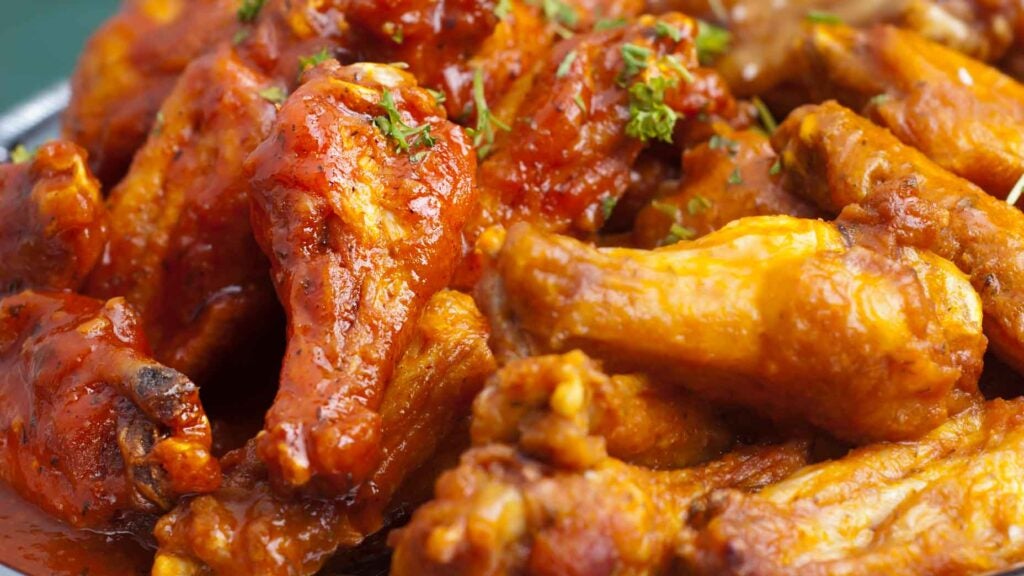If you ever need a wingman, Blake Johnson is your guy.
As executive sous chef at the Fazio Pub, at Champion Hills, a private golf community in North Carolina anchored by a pristine Tom Fazio design, Johnson plays a key role in a kitchen that turns out spot-on clubhouse fare. Though elements of the menu shift with the seasons, one item never changes “or else there’d be a mutiny,” Johnson says.
No one messes with the chicken wings.
The preparation is beautifully simple. The wings are par-baked until they’re just cooked through, then deep fried to order and tossed with a choice of three sauces: traditional spicy buffalo, teriyaki ginger or chipotle barbecue, with refreshing celery sticks on the side.
That’s one winning method. But there are many ways to whip up killer wings, provided you abide by a few fundamentals. We asked Johnson for a bird’s-eye guide of the dos and don’ts.
DO: Start with meaty wings
In North Carolina, there is no shortage of free-range, farm-fresh local chicken. Amid all the options, Johnson has found that the bigger and meatier the wings, the better. “You have more connective tissue, and more marbling,” he says. And more juicy, chicken flavor in every bite.
DO: Give par-cooking a try
Par-cooking — a technique that involves partially cooking food that can be finished later — is especially useful in restaurant kitchens, as it gets time-consuming prep work out of the way so that dishes can be easily made to order. But par-cooking has other upsides. In the case of wings, it also renders fat out of the skin, which helps the wings get nice and crispy, even as it bastes the meat in its own juices. At the Fazio Pub, they par-bake their wings at 350 degrees for roughly 25 to 35 minutes (they’re looking for a meat thermometer reading of 165 degrees), then deep fry them to order. You can do the same at home, though you don’t have to finish your wings in a deep fryer. You can also air-fry them, slap them on the grill or finish them in the oven with the temperature turned up to 425 degrees. If you opt for the oven method, Johnson recommends cooking the wings on a wire rack, which allows the fat to drain and the air to circulate evenly around the wings, resulting in more uniformly crispy skin.
DON’T overdo marinades, brines and dry rubs
At the Fazio Pub, they don’t season the wings prior to cooking. No marinade. No dry rub. Not even salt. Part of the reason, Johnson says, is that salt and other seasonings would break down and dirty up the oil in the deep fryer. What’s more, he notes, the wings develop plenty of flavor through baking and frying, which is further enhanced when they’re tossed in sauce. “The attitude around here is, If it’s not broken, don’t fix it,” Johnson says. “So we stick to what we’ve been doing.”
Not that Johnson is opposed to marinades or brines. In fact, he says he favors them for home cooks if you’re finishing your wings in the oven or on the grill. Just take care not to brine or marinade the wings for too long. Even 30 minutes is probably plenty, Johnson says. Anything beyond four hours is overkill.
DO: Temper the wings
Meaning, take them out of the fridge and let them come to room temperature before you put them in the oven to cook them evenly. Start them cold, and you’re more likely to wind up with wings that get crispy on the outside before their insides are fully cooked through.
DON’T crowd them
Your wings will give off heat and moisture as they cook, so leave space between them when you place them in the often. You want to bake them until they’re brown and crispy. Crowd them all together, and you run the risk of steaming them instead.
DON’T toss in cold sauce
Cold and chewy wings are a culinary buzzkill. But that’s what you’ll get if you toss them in cold sauce. No need to bring the sauce to a roiling boil; that will only thin it out and keep it from clinging to the wings. Just heat it gently to shake off any refrigerator-chill.
DO: Serve with a choice of sauces
Wings are party food, meant for sharing. But different partygoers have different tastes. When you’re making wings at home, Johnson recommends offering a choice of sauces, at least two, if not more, ideally with contrasting profiles, like a cooling ranch and a spicy buffalo. Instead of tossing the wings in them, Johnson says, you might consider serving the sauces on the side, “so everyone has a chance to customize to their liking.”
